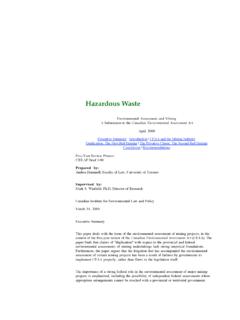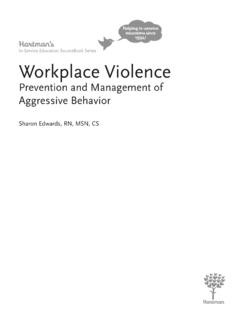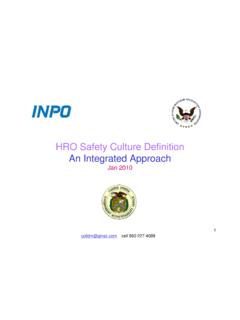Transcription of Recommendations for improved weed management
1 Recommendations for improved weed managementTC/D/A0884E/1 photos (from left to right)- Checking the presence of natural enemies on water hyacinth, Namulonge, Colombian farmers assessing weed bank in Post-emergence herbicide treatment in a new citrus plantation, Jag ey Grande, Counting weeds using a square Wedelia trilobata stand in assessing weed species in the field. Page I. Introduction 1 Weeds as agricultural pests 1 Development of weed management in developing countries 2 The need to develop improved weed management 5 II. Weed management as part of plant protection services 6 The objective of the work on weeds in plant protection services 6 Activities to develop 6 III. The importance of the systematic evaluation of weed stands 11 The behaviour of weed flora11 Evaluating weed populations 11 The importance of the work of the agricultural extension service and farmers in evaluating weed populations 13 The importance of correct weed identification 14 Forecasting or predicting weeds 14 IV.
2 Weed Research 17 Weed ecobiology 17 Weed interference with crop 20 Weed competition 20 Economic weed thresholds 21 Allelopathy 22 Parasitism 22 The development of weed control or management strategies 23 Preventative methods 25 Legal measures 25 Other preventative measures 26 Cultural methods 26 Land preparation 26 Crop rotation 27 Intercropping 27 Living cover 28 Mulch 28 Chemical control 28 Herbicide trials for registration 29 Evaluating the use of herbicides in the context of crop management 30 Herbicide persistence in soil, water and crop produce 30 Herbicide-resistant weeds 31 Genetically modified herbicide-resistant crops (HRC) 32 Biological control 32 Classical biological control 33 Augmentative biological control 34 Integrated weed management 34 Assessment of the cost/benefit of weed management 35 V.
3 The importance of stable links between research and agricultural extension on weeds36 VI. Working with farmers 37 VII. The role of the authorities of the Ministries of Agriculture and Rural Development in the implementation of weed management 39 VIII. The importance of implementing projects on weed management 40 IX. The importance of publications on weed management41 X. Useful Literature on Weeds 42 a) magazines 42 b) related books, reports and booklets 42 c) available websites on weeds 46 XI. Conclusions48 References 49 Acknowledgment The author sincerely thanks the cooperation of Drs. Peter Kenmore, Plant Protection Service, FAO, Rome, and Bernal Valverde, Department of Agricultural Sciences, Royal Veterinary and Agriculture University, Copenhagen, Denmark, for their time in the revision of this material and for their useful suggestions and Recommendations . Recommendations for improved Weed management / 1 I.
4 Introduction Weeds as agricultural pestsThe noxious incidence of undesirable plants, also known as weeds, is one of the major constraints to world agricultural production. Weeds are plants that under certain conditions cause economic and social harm to the farmers. In the agro-ecological context, weeds are a product of the inter-specific selection brought about by humans since they began cropping, which affected the soil and the whole habitat. The process of selection is continuous and depends on the practices adopted by the farmer. The present use of chemical herbicides has caused important changes of weed flora in cropping areas, including those of prevailing species as well as biotypes of other species becoming resistant to the commonly used chemical herbicides. The damage caused by weeds is seen in various ways and seriously affects various agricultural processes.
5 Weeds cause problems due to: competition with crops for nutrients, water and light; the release of root exudates and foliar leachates toxic to crops; the creation of a favourable habitat for the proliferation of other pests (arthropods, mites, pathogens and others), serving as hosts for them; interference with the normal harvesting process and contamination of produce. Recommendations for improved Weed management / 2 Losses caused by weeds may be from 5 to 10 percent in the agriculture of developed countries, while losses can be up to 20 to 30 percent in developing or emerging countries, those that depend to a greater extent economically on their agricultural production. Development of weed management in developing countriesHot climatic conditions with high solar radiation of tropical and sub-tropical countries favour the predominance of C-4 photosynthesis plants, some of which are very aggressive and undesirable species, generally well adapted to the adverse conditions of high temperatures and drought, and which easily interfere with the growth and development process of crops.
6 In developed nations, weed control is carried out mainly through the combined use of mechanical operations and chemical herbicides. This practice is also well extended in large areas of crops grown extensively in developing countries, such as sugar cane, wheat and citrus. While these control methods are highly productive, there is concern over their effect on soil fertility and the environment. It is for this reason that several developed countries, particularly in Western Europe, have established policies to reduce or rationalize the use of chemical herbicides by adopting to a greater extent cultural practices and biological control. In most of the poor or developing countries, however, the small farmer and his/her family usually spend more than 40 percent of Most of the dominant weed species in tropical and sub-tropical areas are the C4 photosynthesis plants, which are better adapted to a hot and dry environment, having enhanced water absorption and a more efficient use of soil moisture and sunlight.
7 In these climatic zones there are two C4crops maize and sugarcane. Recommendations for improved Weed management / 3 their time in hand weeding, which limits agricultural productivity and the improvement of their standard of living and culture. It has also been proved that hand-weeding does not always benefit the farmers, because in some circumstances they control weeds out of the critical period of weed competition, when most of the damage caused by the weeds has already been done. In the framework of sustainable agriculture development, it is necessary to develop improved methods of weed control, which should provide better productions at economically feasible levels without affecting the environment. The results of a survey conducted by FAO from 1991 1994 (Labrada, 1996) demonstrated that in general little attention is given to the problem of weed control in developing countries due to: Insufficient knowledge of the damage and losses caused by weeds on the part of farmers and officials of the ministries of agriculture and rural development.
8 While in developed countries weed management is done through the use of herbicides and machinery, in poorly developed or developing countries, particularly at the small farm level, the farmer and his/her family spend more than 40 percent of their labour time in hand-weeding operations. This situation limits the productivity of the farmers and the socio-economic development of their family. Recommendations for improved Weed management / 4 Lack of attention to the problem of weeds by the national plant protection services. An example is that the plant quarantine departments of these services in some countries do not have a list of exotic weed species whose entry into the territory of the country should be avoided. Especially under commercial and trade pressures there is neither control nor analysis of new imported shipments of plant origin for detecting the presence of exotic weed species.
9 Further, no risk assessment of the possible introduction and adaptation of these species is conducted. The absence of national research programmes on weed ecobiology and control. In a large number of countries there are only schemes for herbicide trials financed essentially by the agrochemical industry. Weak or absent links between the weed research programmes and agricultural extension services, leading to a lack of technology transfer for farmers. Insufficient publication of scientific papers on the biology of weeds and appropriate methods for their control, and lack of bulletins with practical information for growers. Lack of pre- and post-graduate courses on weed management at the university level. Vague aspects of weed control are usually discussed in other subject matters, such as agronomy and general plant protection. Recommendations for improved Weed management / 5 The need to develop improved weed management improved weed management in the agriculture of developing countries is needed for the development of Integrated Crop management (ICM).
10 There is no ICM without a strong component of weed management . Plant protection services, research and agricultural extension must deal with the problem of weed control through the necessary farmer education, and publishing leaflets and bulletins on the subject. Based on the importance of weed control for sustainable agriculture, FAO has decided to prepare and publish the present practical guidelines as a modest contribution to the efforts of developing countries to secure food for their population. The improvement of weed management practices is neglected in many developing countries due to: lack of information on yield reduction caused by weeds; lack of courses on weed management in agronomic studies at the university and medium technical level; lack of applied research programmes in the topic of weeds and of transfer of new technology of weed control for farmers; weak links between research and agricultural extension.















